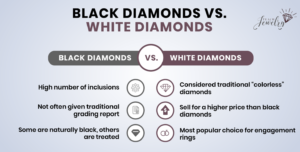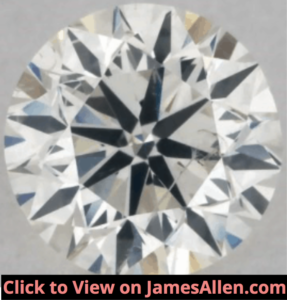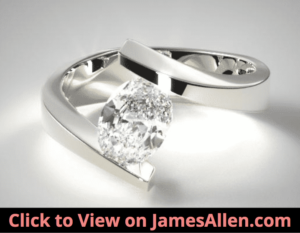
Most diamond shoppers quickly narrow their selection to a white diamond.
But many diamond retailers have more to offer than just white diamonds, and in recent years, black diamonds have seen higher demand as buyers consider the striking, bold look of a dark diamond.
The main difference between black and white diamonds is black diamonds are filled with clarity characteristics, which are blemishes that developed during its formation. White diamonds are colorless and often free of inclusions, which allows them to exhibit strong brilliance.
We’ll compare black diamonds versus white diamonds across their primary characteristics, such as composition, price, shapes, durability and more so you’ll be informed about which is right for you.
What is a Black Diamond?
Black diamonds have a high number of inclusions that result in the diamond appearing completely dark.
Most white diamonds also have inclusions that form as dark specks on the inside, but when there are enough inclusions to cover the whole diamond, it instead turns black.
Take a look at the image below of a black diamond.

It’s an extremely dark diamond, but some have a lighter shade.
They’re part of a category of diamonds called fancy colored diamonds, which also include blue, yellow, and pink diamonds.
Even though they have a distinct look from the classic, colorless ones, black diamonds are real diamonds.
There are two types of black diamonds.
The first are called natural black diamonds, and they turn from white to black during the formation process. They contain large quantities of mineral inclusions such as graphite, hematite, and pyrite, and these inclusions expand throughout the stone.
It results in a metallic aesthetic.
The other type of black diamonds are ones that have been treated to change the appearance.
The manufacturer starts with a white diamond that often has a high number of fractures and inclusions.
That means it already has a grey appearance. It’s then placed under a high-temperature, low-pressure treatment to bring about the black color.
What is a White Diamond?
White diamonds appear colorless because of their lack of inclusions.
The high-resolution image below is of a colorless diamond.
They’re considered the traditional style, and the most valuable ones are completely colorless. In the example above, you’ll notice how some of the facets on its edges appear yellow. This is because it’s rare for a diamond to have no shades of color.
As you move down the GIA color scale from D (colorless) to Z, there will be stronger hints of yellow and brown to the point you wouldn’t consider it a white diamond.
Most diamonds mined are white, and their exact color grade is then determined by the extent to which those tints are present.
Even a white diamond with dark specks scattered throughout is still considered a colorless diamond.
It just won’t score as high on the GIA clarity scale.
How are Black and White Diamonds Different?
1. Composition
Black and white diamonds have similar composition.
They’re both formed when high amounts of pressure is placed on carbon about 100 miles below the Earth’s surface. The mineral is transported from deep within Earth to the surface, where they’re then mined.
The difference in the composition between black and white diamonds is black diamonds have a graphite inclusion that white diamonds lack.
When placed under a diamond tester, both will test as real diamonds.
2. Price
There are significant differences in price for black diamonds versus white ones. But the key to understanding the price for black diamonds is knowing whether it’s natural or treated.
Natural black diamonds are priced with a premium compared to treated ones, even though their demand relative to white is still lower.
For a natural, fancy black diamond, you can expect to pay $1,500-$2,000 for one carat.
For example, check out this 1.13-carat round-cut black diamond.
It has a natural origin with an even color distribution. It costs $2,010.
As you move to higher carat weights, the price increases exponentially, so the same quality diamond at two carats can cost between $3,700-$5,200.
If you compare that to a colorless diamond, such as one with a VS1 clarity grade, G color, and very good cut, you can expect to pay between $5,000-$6,000.
To illustrate, here’s a white diamond that earned those grades.
It’s priced at $5,380.
The price of a diamond is determined by many qualities aside from its color of black or white, but in general, even a rare, natural black diamond will cost less than a similarly-graded white one.
The discrepancy is even more pronounced when comparing treated black diamonds to white ones. Treated black diamonds are made from low-quality white ones that have an excessive number of inclusions, so they have less value in the marketplace.
Additionally, there’s a lower demand.
For example, you can purchase this 1.50 carat black diamond treated with heat, including a 14kt white gold band setting, for $1,400. Even if you moved up to two carat diamond, the price only jumps to $1,700.
These examples show the demand and resulting prices are highest for white diamonds, followed by natural black diamonds, and then treated black diamonds.
3. Origin
White diamonds are the most popular color found in mines around the world.
The downside is many of these white diamonds are low quality, small, and full of inclusions, so the demand and price for quality white diamonds remains high.
In addition, most have strong shades of yellow and brown, so they don’t appear colorless even to the naked eye.
Natural black diamonds are mostly mined in Brazil and Central Africa. Treated black diamonds can come from anywhere because all it requires is a white diamond with inclusions.
4. History
White diamonds have always been held in high regard and prized for their clarity and brilliance. Black diamonds, on the other hand, were traditionally thrown out.
That changed in the late 20th century, when designers started promoting them in pieces of jewelry as a way to contrast colorless diamonds.
To illustrate, here’s a pendant holding a black diamond.

Now, they’re used in necklaces, earrings, and more as a bold choice for those shifting away from the classic styles.
5. Clarity
Fancy black diamonds do not receive a clarity grade in the same way white diamonds do. The extent of inclusions in a black diamond versus a white diamond leaves little to compare.
If you’re reading the GIA report for a black diamond, you’ll notice the clarity grade isn’t listed on the report.
In the example below, it lists carat weight, color grade, origin, and color distribution.

On the report for a white diamond, this section includes the clarity grade labeled from flawless to I3.
But that doesn’t mean you shouldn’t consider the clarity for each.
For black diamonds, check that there aren’t any obvious defects visible to the naked eye. Those purchasing a black diamond often want a dark, solid black.
Some inclusions can inhibit the pure shade they desire.
For white diamonds, the ones with the best value have inclusions only visible through a microscope. You’ll avoid the price premiums for ones at the top of the clarity scale, but it’ll appear identical when viewed in a normal setting.
If you’re looking for an eye-clean diamond, I recommend starting your search at SI1 and working you way up the scale until you find the right choice for you.
6. Shapes
Black diamonds come in all the same shapes as white ones. That’s because they’re often cut with a laser, which can turn the rough diamond into almost any shape.
From the popular round shape to fancy ones such as pear and cushion, you can decide which shape is the right style for you.
The image below shows black diamonds as pear, round, marquise, and cushion cuts.

The most popular shapes for each are round, but others such as princess, Asscher, and oval are trending upward.
7. Durability
The issue of durability is an important consideration in comparing black versus white diamonds. The presence of inclusions, especially large ones near the edges of a diamond, generally warrant concern about its susceptibility to chipping.
Inclusions can create weak points in the diamond, so a natural black diamond filled with inclusions is less durable than a white one without them.
Be mindful of choosing a black diamond with sharp corners that has inclusions in those areas. They represent weak points in the diamond.
On the pear-cut black diamond below, I’ve highlighted its sharp corner.

On the other hand, white diamonds that were treated to become black are considered just as durable because the treatment doesn’t add those weak points.
But both black and white diamonds are still rated a perfect 10 on the Mohs scale of hardness, so you should only be concerned about durability if either experiences a hard impact.
A solution to this problem is protecting the diamond with a strong setting that can withstand the damage. For example, you might consider a bezel setting, which is a ring of metal that wraps around its edges.
This contrasts with a four-prong setting, where it’s only held by thin metal claws.
8.Light Performance
Light performance is a coveted quality in diamonds because buyers want it to sparkle and glimmer as it twirls.
When comparing white diamonds to each other, the most important aspect to consider is the cut. All else being equal, a diamond with an excellent cut will outshine ones with very good, good, or poor cuts.
The difference in light performance between black versus white diamonds is pronounced. That’s because the crystal structure and inclusions in a black diamond don’t reflect light. Instead, they absorb it.
White diamonds capture light and then reflect it outward through the table to create its shine. One of the reasons they’re the most popular type of diamond is because of its brilliance.
You can spot its brilliance by rotating this image on the vendor’s website.
As it turns 360-degrees, notice how some of the facets appear to turn on and off with white light.
Choose a white diamond with a round cut that scores excellent on the GIA scale, and it’ll have some of the best sparkle you can find.
9. Color
Color is the most noticeable difference between black and white diamonds. The two emerald cuts below show the distinction.
White diamonds are graded along the GIA scale, denoting where it sits between completely colorless and having a strong yellow or brown tint.
Black diamonds aren’t graded on this same scale. Unlike other fancy colors such as red or pink, black diamonds only come in one color: fancy black. Those other colors are specified by their intensity grade, such as fancy light, fancy dark, or fancy deep.
Even though black diamonds aren’t graded by their intensity, some have stronger tones than others. You should always examine the diamond in person or in a high-resolution photo before buying so you know the intensity of the color.
You may want a pitch black diamond or one that borders grey. Many diamond retailers have a range of tones available for black diamonds.
10. Certification
The GIA has separate grading systems for white and black diamonds. White diamonds are graded along the four Cs of color, cut, clarity, and carat, as well as many other qualities. These include symmetry and polish, fluorescence, and specific inclusions.
Black diamonds aren’t given a traditional grading report. Instead, the GIA provides a colored diamond identification and origin report. It features some of the same measurements as a white diamond, but also includes whether it’s natural or treated color.

The report also documents the color distribution, so you know whether it’s evenly distributed throughout the diamond or is concentrated in one area.
The GIA report for the emerald cut diamond above shows the color distribution is even.

Another area of distinction is the GIA doesn’t grade black diamonds on the clarity scale. They’re often heavily included and are opaque, so it’s clarity isn’t a factor in determining its value.
11. Settings
There are a variety of settings available for both black and white diamonds. There isn’t a right or wrong setting for either, but popular styles for black diamonds are three-stone and halo settings.
For example, this three-stone diamond ring features a 2.2 carat fancy black diamond surrounded by two white side stones. The contrast continues down the shank with smaller colorless diamonds.

Similar to the three-stone setting, this halo micro pave diamond engagement ring has a 1.8 carat black diamond surrounded by dozens of smaller white accents. It commands the high price because all the diamonds are untreated.

It’s recommended the band consist of platinum or white gold because its brightness will contrast the black diamond.
For white diamonds, the most popular is a prong and solitaire setting. This classic look features a single white diamond held in place by four or six prongs.
The second most popular setting is a bezel setting. Metal encircles the diamond, covering all its edges to hold it in place. It’s considered the most secure setting but does cover more of the diamond than prongs.
If you desire a unique setting, one of the most modern styles is a tension setting. It works for both black and white diamonds. The ends of the curved band hold the diamond in place in a way that looks like it’s suspended in mid-air.
The downside of this style is it doesn’t allow for covering up any inclusions, but the upside is there’s no part of the diamond that’s hidden.
Is a Black or White Diamond Right For You?

White diamonds are significantly more popular than black diamonds, but that doesn’t mean you should immediately go the traditional route.
Here are some criteria to help you decide.
Consider a white colorless diamond if:
- You want it to match the traditional style for engagement rings and other jewelry
- You’re willing to pay a premium over a colored one
A black diamond might be right for you if:
- It’s dark, striking colors are appealing
- You’re looking for an everyday piece of jewelry that differs from the traditional style
The most important aspect of purchasing a black or white diamond is knowing exactly what you’re paying for by ensuring its quality matches the price.
Once you’ve decided on the right diamond, you can let it complement your personal style for years to come.

Jacob Clarke
Jacob Clarke is the founder of TeachJewelry.com.
He earned an Applied Jewelry Professional Diploma from the Gemological Institute of America (GIA) and now brings you essential information about diamonds, settings, and more.
Jacob has consulted with leading jewelry brands, and his work has been cited in Clean Origin, Diamond Nexus and industry publications.
He's also a member of the International Gem Society.
He enjoys discussing jewelry with readers, so contact him with any questions at jacob.clarke@teachjewelry.com.


















